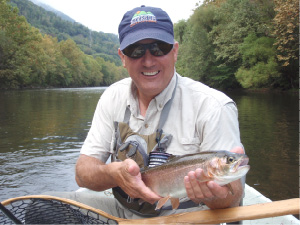
By Kenneth L. Kieser
Northeast News
Aug. 3, 2011
Waist-high water shot through a canyon filled with heavy boulders, slippery sand and various types of fish. I stepped carefully to avoid taking a cold swim in the tail water section of Virginia’s Jackson River, an uninviting experience in heavy waders. Sweat dripped down my forehead until a welcome cool breeze slipped over the water surface, creating an air conditioning effect that made inhaling a deep breath of sweet mountain air a pleasure.
I stopped and took a long look at the beautiful Blue Ridge mountainsides filled with various hardwood trees starting to show fall colors. I briefly thanked God for allowing me to be in this paradise while taking my mind off the task of walking on a cluttered river bottom. I took another step and almost went head over heels when one of a million submerged rocks tipped, throwing my weight off balance. I immediately shortened my steps and moved forwardmuch slower.
I held a lightweight flyrod in my right hand making balance even more of a challenge. But I was after a fish that is hard to find in the United States, a wild mountain rainbow trout. Sure, most of us have caught stocked rainbows raised in a hatchery, but as Tom Kirlin, my guide from Clifton Forge, Va., had told me, “These fish are hatched in our waters and are wild and wary.”
His words proved to be true.
I finally reached the far bank that was covered in bushes of different varieties. My flyrod, a six weight Sage ZLX, was pre-rigged on the bank to avoid tying on leaders and a fly while rushing water slammed against my legs. I looked around the scenic area and then started stripping floating weight-forward flyline. The expensive line slipped back and forth through the air until I had fed enough out to make an adequate presentation.
Soon my fly gently landed against the bank and slightly under a bush. I focused on the spot, not trying to see the fly, a size 18 Poison Tung. I could place three of the tiny flies on my thumb, meaning it was invisible to my old eyes from 10 feet away. A slight twitch of the fly must have given it a lively appearance because a boil of water showed a trout took the bait. I raised my rod to set the hooknothing!
The rainbow had taken the bait, quicker than any human mind could register, and I missed the hook set. I tried again while grumbling under my breath, same result. The wild trout were just too fast. I slipped more line out to a different spot, made sure my line was tight, a challenge in the fast-moving water, and waited. The strike came quick as a flash of lightening but my barbless hook drove home.
My six weight flyrod took a deep bend as the wild trout started diving and running for the safety of rocks or brush. I clearly had hooked a good trout, maybe over four pounds I surmised while picking up line whenever possible. Finally the trout was close and I looked down to see what might have been a pound fish that fought like a lunker. I slipped my net in the water and then released it. The darned fish would not give up.
The little trout used up his allotted energy minutes later. I admired it in my net, with vivid colors of pink and salmon that rivaled numerous hatchery trout I had caught over the years. I released the fighter and was splashed by cold water as it disappeared. That trout was still active and I learned why they called their trout wild.
“I especially like to fish this stretch of water on bright sunny days in January or February,” Kirlin said. “We catch a lot of rainbow and brown trout then and they were all wild reproduced here. The river is 50 to 60 degrees then because it is warmed in the dam.”
Most trout caught throughout the summer are hit and miss. Other rivers in the area provide smallmouth and largemouth bass fishing. But purists return to the stream in the fall for another bout with wild mountain trout.
“We have a lot of insect hatches in the fall,” Kirlin said. “Today the current was brisk and our flies were moving quickly between the back eddies and main flows. Areas where it was significantly deeper around bigger boulders where food was dropping down to the trout. We usually catch a lot of fish in these areas.”
ROANOKE, VIRGINIAI was introduced to one of America’s most unique towns the evening before my wild trout adventure. Roanoke, Va., located about three hours from mountain trout fishing, is a mixture of old and new. Their new modern art museum, The Taubman Museum of Art, is shadowed by old electronic outdoor advertisements of Dr. Pepper and many other nationally known symbols, reminding many of us of the 1960s.
Their symbol, a 100-foot, 10,000-pound star shines over the city on a nearby mountain bluff. The Roanoke Star has sat in this spot since 1949 and efforts were recently made to restore it.
The Virginia Transportation Museum features old trains, the biggest diesel collection in the country and other vehicles including rare cars, trucks and a hearse from the turn of the century.
I stayed in the Hotel Roanoke, a well furnished and beautiful structure built in 1882. Perhaps best of all, the food is excellent and they do know how to cook a steak. Nightlife in the town is lively and women or kids are safe walking alone on the streets at night. Some call Roanoke one of America’s best kept secretsand I agree!
Want to try your hand at catching a wild mountain trout in Virginia? Then call Tom and Dawn Kirlin at: (540) 862-7999 or check their website at: www.riderupoutfitters.com. For more information on Roanoke, call (540) 853-2000 or check their website at: www.roanokeva.gov. To contact the Virginia Transportation Museum, call: (540) 342-5670 or go to www.virginiatransportationmuseum.com.

















